Blank L., Tarquin A. Engineering Economy (McGraw-Hill Series in Industrial Engineering and Management)
Подождите немного. Документ загружается.

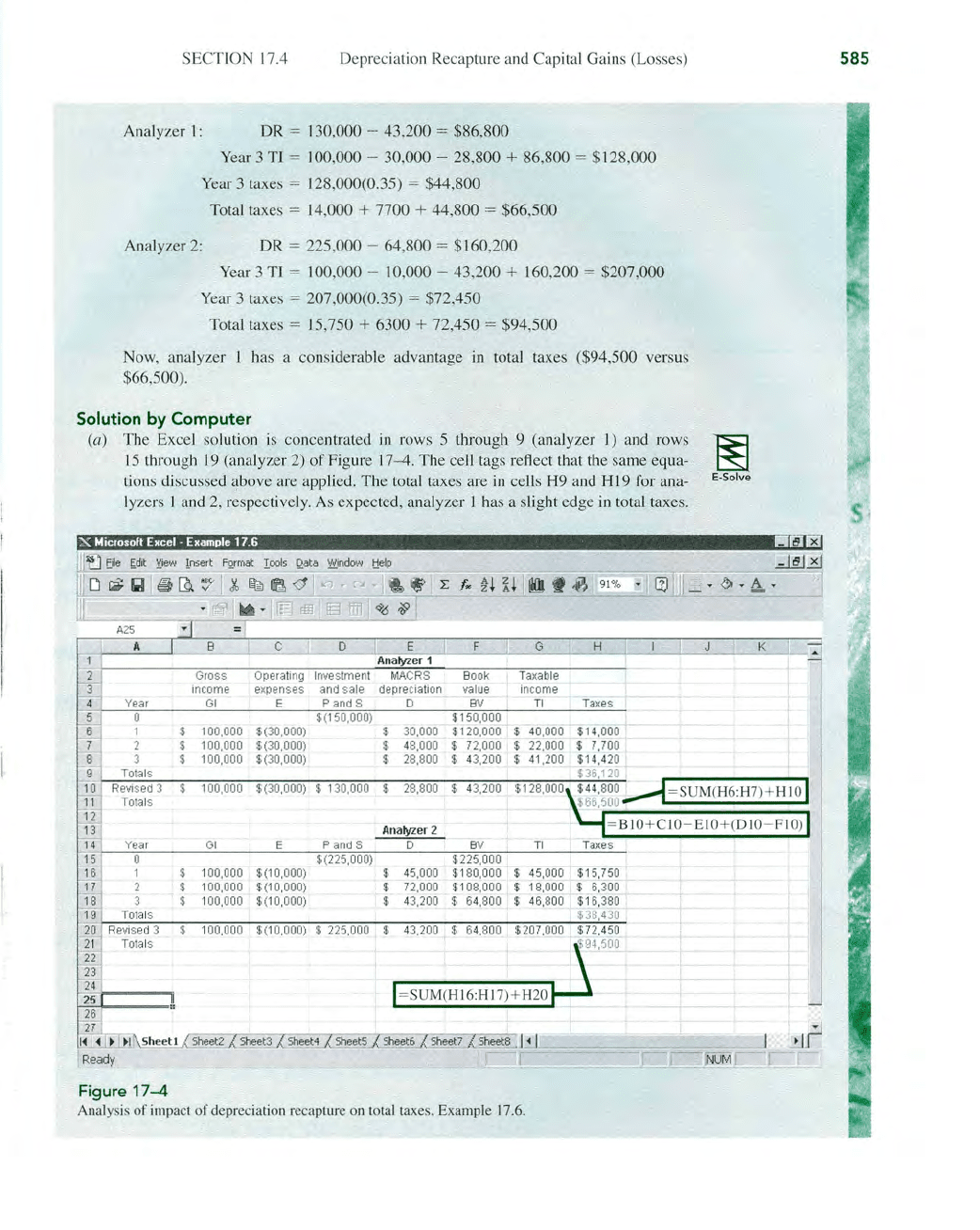
SEC
TION
17.4
Deprecia
ti
on Recapture and
Ca
pital Gains (Losses)
Analy
ze
r I :
DR
= 130,
000
- 43,2
00
= $86,8
00
Year 3
Tl
= J 00,
000
-
30
,0
00
- 28,8
00
+ 86,800 = $128,
000
Year 3 taxes = 128,
000
(0.35) = $
44
,800
Total taxes = 14,
000
+
7700
+
44,800
= $66,
50
0
Analyzer
2:
DR
=
22
5,
000
- 64,8
00
= $ 160,2
00
Year 3
Tl
= 1
00
,
000
- 10,
000
-
43
,
200
+ 160,200 = $207,000
Year 3 t
axe
s =
207,000
(0.35) = $72,
450
Total taxes = 15,
750
+
6300
+ 72,450 =
$94
,
500
Now
, analyzer J has a cons
id
erab
le
advantage in total taxes ($94,500 versus
$66,
500
).
Solution
by
Computer
(a) The Ex
ce
l so
lu
tion is concentrated
in
rows 5 through 9 (analyzer I) and rows
15
th
rough 19 (analyzer 2)
of
Figure 17--4. The
ce
ll
tags
re
fl
ect
th
at
the same e
qu
a-
tions discussed above are a
pp
lied. The total taxes are in cells
H9
and H 19 for ana-
lyzers I and 2, resp
ec
ti
vel
y.
As
expecte
d, anal
yze
r J has a s
li
ght edge
in
total taxe
s.
~
E-Solve
~
Microsoft Excel - Example 17.6
II
A25
A
1
2
Gross Operating
Investment Book
Ta
xa
ble
3
income
ex
penses
and sale depreciation value
income
4 Year
GI
E P and S D
BY
TI
Taxes
5
0 $(150,000) $150,000
6 100,000
$(3
0,000) 30,000 $120,000
40
,000 $14,000
7 100,000
$(30,000)
48
,000 $ 72,000
22,
000 $ 7,700
8
100
,0
00
$(30,000)
28,800 $ 43,200
41
,2
00 $14,420
9
Totals $36,120
10
Revised 3 100,000
$(30,000)
.$
130,000 28,800 43,200 $128,000
$ 44,800
~
= SUM(H
6:
H
7)
+ H I 0 I
11 Totals
$66,5(10
12
= BIO+ CIO- EIO
+(
D I 0- F l
O)
13
A
na
lyZ
er
2
14
Year
GI
E P and S D
BY
TI
15 0
$ (225,000)
$225,000
16
100,000
.$
(10,000)
45,000 $180,000
45,
000 $15,750
17
100,000
$
(1
0,000)
72,000
$1
08,000 18,000 $ 6,300
18
100,000
$ (10,000)
43,200
$ 64,800 46,800 ' $16,
38
0
1 9 Totals $38
,4
30
':
1"tf
Revi
sed 3 1
00
,000 $ (1 0,000)
$ 225,000 43,200
.$
64
,8
00 $ 207,000
$72,450
21
Totals
~
94
,
5[1
0
22
23
=
SU
M(H I6:H17)+H20
R
ea
dy
Figure
17-4
Analysis of impact of depreciation recapture on total taxe
s,
Example 17.
6.
585
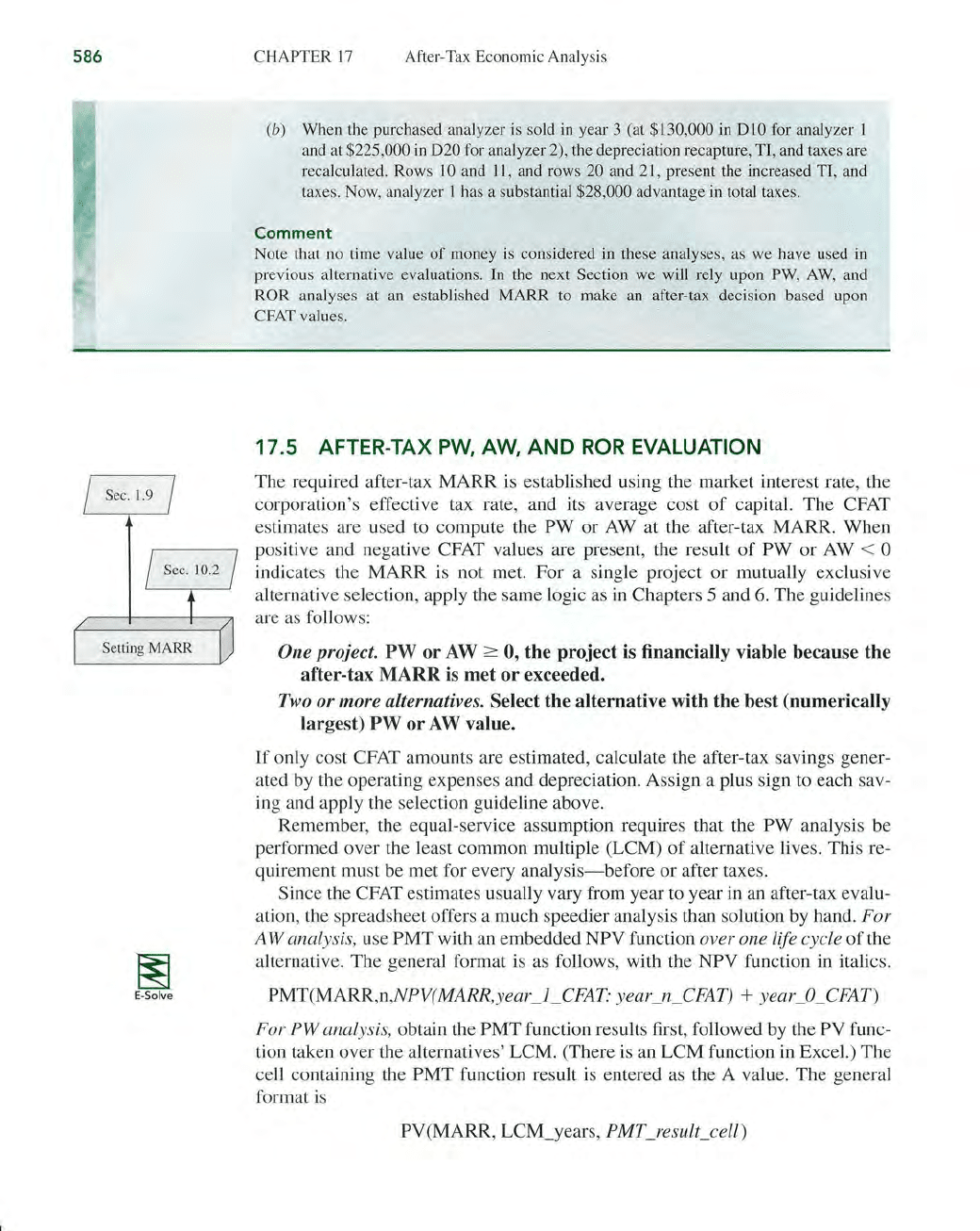
586
Setting MARR
CHAPTER
17
After-Tax Economic Analysis
(b) When the purchased analyzer is sold in year 3 (at $130,000 in
DlO
for analyzer 1
and at
$225,000 in
D20
for analyzer 2), the depreciation recapture, TI, and taxes are
recalculated. Rows 10 and
11,
and rows 20 and 21, present the increased TI, and
taxes. Now, analyzer
I has a substantial $28,000 advantage in total taxes.
Comment
Note that no time value
of
money is considered in these analyses, as we have used
in
previous alternative evaluations. In the next Section we will rely upon
PW
,
AW,
and
ROR analyses at an established
MARR
to make an after-tax decision based upon
CFAT values.
17.5 AFTER-TAX
PW,
AW,
AND
ROR
EVALUATION
The required after-tax MARR is established using the market interest rate, the
corporation's effective tax rate, and its average cost
of
capital. The
CFAT
estimates are used to compute the PW or
AW
at the after-tax MARR. When
positive and negative
CFAT
values are present, the result
of
PW or
AW
< 0
indicates the MARR is not met. For a single project or mutually exclusive
alternative selection, apply the same logic
as
in Chapters 5 and 6. The guidelines
are as follows:
One project.
PW
or
AW 2': 0,
the
project
is financially viable because
the
after-tax
MARR
is
met
or
exceeded.
Two or more alternatives. Select
the
alternative
with
the
best (numerically
largest)
PW
or
AW value.
If
only cost
CFAT
amounts are estimated, calculate the after-tax savings gener-
ated
by
the operating expenses and depreciation. Assign a plus sign to each sav-
ing a
nd
apply the selection guideline above.
Remember, the equal-service assumption requires that the
PW analysis be
performed over the least common multiple (LCM)
of
alternative lives. This re-
quirement must be met for every
analysis-before
or after taxes.
Since the
CFAT
estimates usually vary from year
to
year in
an
after-tax evalu-
ation,
th
e spreadsheet offers a much speedier analysis than solution by hand. For
A W analysis,
use PMT with
an
embedded NPV function
over
one life cycle
of
the
m alternative. The gener
al
format is
as
follows, with the NPV function in italics.
E-Solve
PMT(MARR,n
,NPV(MARR,ye
ar
_LCFAT.· year _n_CFAT) + y
ear
_O_CFAT)
For
PW
analysi
s,
obtain the PMT function results first, followed
by
the PV func-
tion taken over the alternatives' LCM. (There is an LCM function in Excel.) The
cell containing the
PMT function result is entered
as
the A value. The general
format is
PV(MARR, LCM_years,
PMTJesulc
cell)
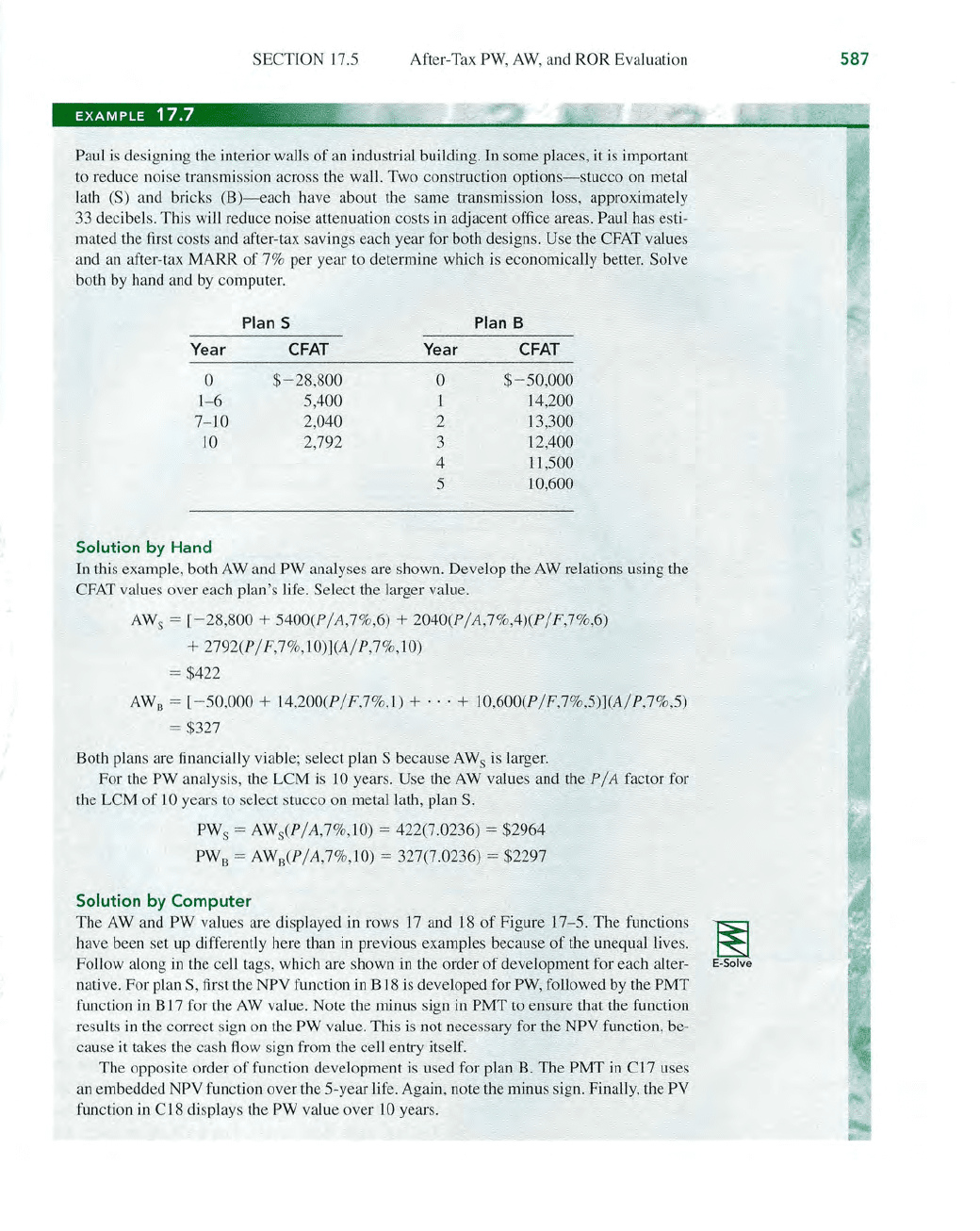
SECTION 17.5 After-Tax PW,
AW,
and ROR Evaluation
Paul is designing the interior walls
of
an industrial building. In some places, it is important
to r
ed
uce noise trans
mi
ss
ion acro
ss
the wall. Two construction options
-s
tncco
on
metal
lath (S) a
nd
bricks (B)
--eac
h have about the same transmission loss, approximately
33
decibels. This will reduce
noi
se attenuation costs in adjacent office areas. Paul has esti-
mated the first costs and after-tax savings each year for both designs.
Use the
CFAT
values
and an after-tax MARR
of
7%
pe
r year to determine which is economically better. Solve
both
by
hand a
nd
by
compnt
er.
Plan S Plan B
Year CFAT Year CFAT
0
$- 28,800
0
$-50,000
1- 6
5,400 14,200
7-
tO
2,040 2 13,300
to
2,792 3
12,400
4 11,500
5
10,600
Solution by Hand
In
this examp.le, both
AW
and PW analyses are shown. Develop the A W relations using the
CFAT
values over each plan's lif
e.
Select the larger value.
AWs
= [- 28,800 + 5400(P
/A
,7
%,6) + 2040(P/A,7
%,
4)(P/F
,7%,6)
+ 2792(P / F,7%, 10)](A/ P,7%,
10)
= $422
AW
B
= [- 50,000 + 14,200(P
/F,
7%,l)
+
...
+
10,600(P/F)
%,
5)](A/P,7
%,
5)
= $327
Both plans are
fi
nancially viab
le
; select plan S because
AWs
is
larger.
For the
PW
ana
ly
si
s,
the LCM is
10
years. Use the AW values and the
PIA
factor for
the LCM of
10
years
to
select stucco
on
metal lath, plan
S.
PW
s
=
AW
s
(P/A,7%,1O) = 422(7.0236) = $2964
PW
B
=
AW
B
(P/A,7%,1O) = 327(7.0236) = $2297
Solution by
Computer
The
AW
and PW values are
di
splayed
in
rows
17
and
18
of
Figure
17
-
5.
The functions
have been set up differently here than
in
previous examples because of the unequal lives.
Follow along
in
the cell tags, which are shown in the order of development for each alter-
native. For plan
S,
fir
st the NPV function
in
B
18
is developed for PW, followed by the PMT
function in B
17
for the
AW
value. Note the minus sign in PMT to ensure that the function
resul
ts
in
the correct sign on
th
e PW value. This is not necessary for the NPV function, be-
cause
it
takes
th
e cash flow sign from the ce
ll
entry itself.
The opposite order
of
f
un
ction development is used for plan B. The PMT
in
C17 uses
an
embedded NPV functi
on
over the 5-year life. Again, note the minus sign. Finally, the PV
function
in
C
18
displays the PW
va
lu
e over
10
years.
587
::
I
~
E·Solve
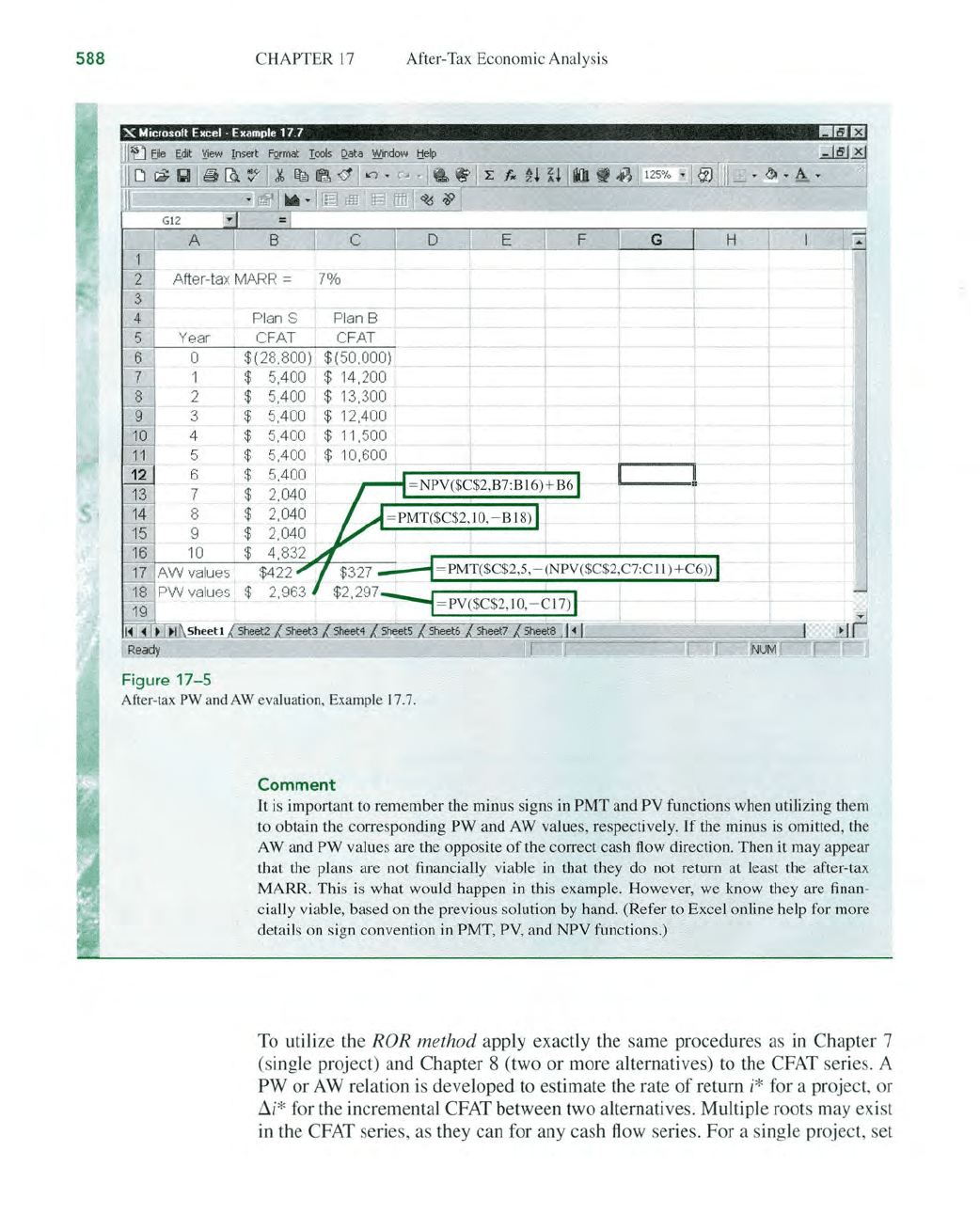
588
CHAPTER 17 After-Tax Economic Analysis
X Microsoft
hcel
- Example 17.7 I!lIiiII3
A
ft
er-tax
Iv1ARR
= 7%
Plan S
Year
CFAT
0
$(28,800)
$
5,400
2
$
5,400
3
$
5,400
4
$
5,400
5
$
5,400
6
$
5,400
7
$
2,040
8
$
2,
040
9
$
2,0
40
10
$
4,832
$422
$ 2,963
Plan B
CFAT
$(
50,000)
$ 14,200
$ 13,300
$ 12,400
$ 11,500
$ 10,600 ,
~--.:.----.;..---.
$327
::::.--i
= PMT($C$2,S
,-(
NPV($C$2
,C7C
II
)+
C6)) I
$2297
,
---"
=
PV
($C$2,IO,- C I7) I
I
~ ~ ~
I She
et
I Sheet2 Sheet3
Ready
I .r
-,'--
Figure
17-5
After-t
ax
PW and AW evaluation, Example 17.7.
Comment
It
is important to remember the minus signs
in
PMT
and PV functions when utiliz
in
g
th
em
to obtain the corresponding
PW
and AW values, respective
ly.
If
the minus is omitted,
th
e
AW and
PW values are the opposite
of
th
e con-ect cash flow direction.
Then
it may appear
that the plans are not financially viable
in
that they do not retum at least
th
e after-tax
MARR. This is what would happen
in
this example. However, we
know
they are finan-
cially viable, based on
th
e previous solution by hand. (Refer to Excel online help for more
det
a
il
s on sign convention
in
PMT,
PV
, and NPV functions.)
To utilize the ROR method apply exactly the same procedures as
in
Chapter 7
(single proj
ec
t) and Chapt
er
8 (two
or
more alternatives) to the CFAT serie
s_
A
PW
or
AW relation is developed to estimate the rate
of
return i* for a project,
or
D.i
* for the
in
cremental CFAT betw
ee
n two alternatives_ Multiple roots may exist
in the CFAT
se
ries, as they
ca
n for any cash flow series.
For
a single project, set
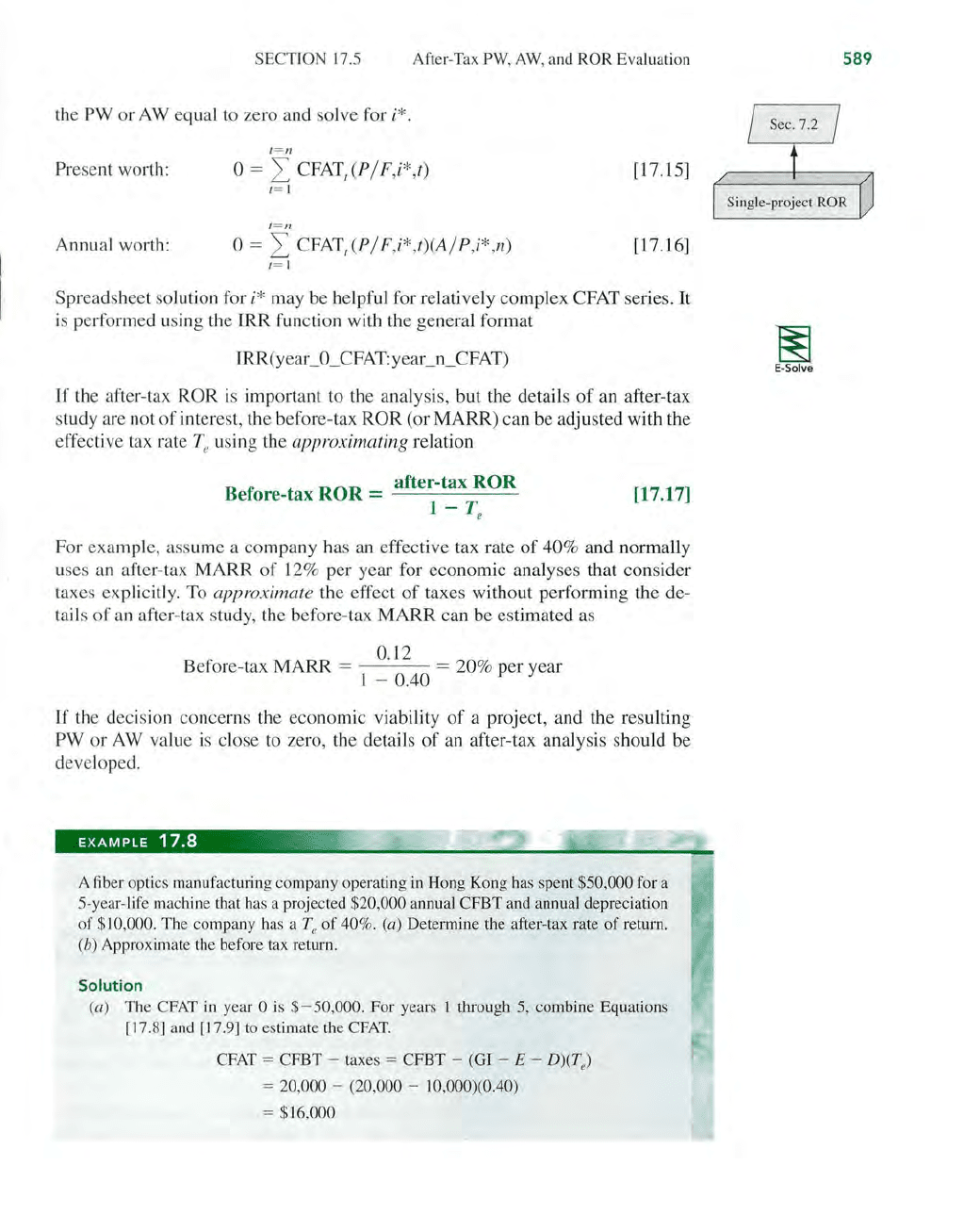
SECTION 17.5 After-Tax PW,
AW,
a
nd
ROR Evaluation
the PW or
AW
equal to zero and solve for i*.
l = n
Present worth:
0 = L CFAT, (P/F,i*,t)
[17.15]
,= 1
{= n
Annual worth:
0 = L
CFAT,(P/F,i*,t)(A/P,i*,n)
[17.16]
,= 1
Spreadsheet solution for
i*
may be helpful for relatively complex CFAT series.
It
is
performed
lI
s
in
g the
IRR
function with the general format
IRR(yeacO
_CFAT:yea
cn
_C
FAT)
If
the
af
ter-tax
ROR
is important to the analysis, but the details
of
an after-tax
study are not
of
interest, the before-tax
ROR
(or
MARR)
can be adjusted with the
effect
iv
e tax rate Te using the approximating relation
B
et
ROR
after-tax
ROR
elore- ax =
1 - Te
[17.17]
For example, assume a company has an effective tax rate
of
40
% and normally
uses an
af
ter-tax
MARR
of
12% per year for economic analyses that consider
taxes
exp
li
citly. To approximate the effect
of
taxes without performing the de-
tails
of
an after-tax study, the before-tax
MARR
can be estimated as
0.12
Before-tax
MARR
=
---
-
20
% per year
-
0.40 -
If
the decision concerns the economic viability
of
a project, and the resulting
PW
or
AW
va
lu
e
is
close to zero, the deta
il
s
of
an after-tax analysis should be
developed.
EXAMPLE
17.8
.~,
A fiber o
pti
cs manufacturing company operating
in
Hong Kong h
as
spent $50,000 for a
5-year-life machine that
ha
s a projected $20,000 annual CFBT and annual depreciation
of
$
10
,000. The company has a Te
of
40%. (a) Determine the after-tax rate
of
return.
(b) Approximate
th
e before tax return.
Solution
(a) The CFAT
in
year 0 is $- 50,000. For years 1 through 5, combine Equations
[1
7.8] a
nd
[17
.9
] to estimate the
CFAT.
CFAT = CFBT - taxes = CFBT - (GI - E -
D)(T
e)
= 20,000 - (20,000 - 10,000)(0.40)
= $[6,000
589
~
E·Solve

590
CHAPTER 17 Afte
r-
Tax
Eco
no
mi
c Analysis
Since
th
e CFAT for years I through 5 has
th
e same value, use
th
e P
IA
factor
in
Equa
ti
on
[17
.15].
0 = - 50,000 + 16,000(P/A,i*,5)
(P/ A,i
*,
5) = 3.125
So
lu
tion gives i
'"
= 1
8.
03% as
th
e
af
ter-tax rate of return.
(b) U
se
Equa
ti
on
[1
7.17] for the before-tax return estimate.
. 0.1803
Before-tax ROR = 1 _ 0.40 = 30.05%
The ac
tu
al before-tax i* using
CFBT
= $20,000 for 5 y
ear
s is 2
8.
65
% from the
rela
ti
on
0 = - 50,000 + 20,000(P/A,i*,5)
The t
ax
effect will be s
li
ght
ly
overestimated if a MARR
of
30.05% is
Ll
sed
in
a
before-tax analysis.
A rate of return evaluation performed by hand on two
or
more alte
rn
a
ti
ves
mu
st utilize a
PW
or AW rela
ti
on to determine the incremental return
t1
i*
of
the
in
cremental CFAT series between two alternatives. Solution by comput
er
is
accomp
li
shed us
in
g
th
e incremental
CF
AT values and the
IRR
functio
n.
The
equations and proce
dur
es applied are the same as in Chapter 8 for selection from
mutua
ll
y exclusive alte
rn
a
ti
ves us
in
g the
ROR
method. You should review and
understand the fo
ll
owing sections before proceeding further with this sectio
n.
Section 8.4
Section 8.5
Section 8.6
ROR
eva
luation us
in
g P
W:
incremental and breakeven
ROR
evalua
ti
on us
in
g AW
In
cremental
ROR
analysis
of
multiple, mutua
ll
y exclusive
alte
rn
atives
From this review, several important facts should be recalled:
Selection
guideline:
The fundamental rule of incremental
ROR
eva
lu
ation at
a stated MA
RR
is as follow
s:
Select
the
one
alternativ
e
that
requires
the
largest
initial
investment
,
provided
the
extra
investment
is
justified
relative
to
another
justified
alternative.
Incremental
ROR:
Incremental analysis must be performed.
Ove
ra
ll
i* va
l-
ues ca
nn
ot be depended upon to select the correct alte
rn
a
ti
ve, unlike the
PW
or A W method at the
MARR
, w
hi
ch will a
lwa
ys indicate the correct
alte
rn
a
ti
ve.
Equal-
s
ervic
e
assumption:
Incremental ROR analysis requires that the
a
lt
e
rn
atives be evaluated over equal time periods. The LCM
of
th
e two
alte
rn
a
ti
ve
li
ves must be used to
fin
d the
PW
or AW
of
incremental cash

SECTION
17.5
After-Tax PW,
AW,
and ROR Evaluation
flows. (The only exception, mentioned in Section 8.5, occurs when the AW
anal ysis
is
performed on actual cash flows, not the increments; then one-
life-cycle analysis is acceptable over the respective alternative lives.)
Revenue
and
service
alternatives:
Revenue alternatives (positive and nega-
tive cash ftows) may be treated differently from service alternatives (cost-
only
cashftow
estimates).
For
revenue alternatives, the overall
i*
may be
used to perform an initial screening. Alternatives that have
i*
<
MARR
can be removed from further evaluation. An
i*
for cost-only (service)
alternatives cannot be determined, so incremental analysis is required with
all alternatives included.
These principles and the same procedures developed in Chapter
8 are applied
to the CFAT series. The summary table
in
the rear
of
the
book
(which is also
Table
10
- 2) details the requirements
of
all evaluation techniques. For the
ROR
method,
in
the column labeled "Series to Evaluate" change the words cash flows
to CFAT values. Additionally, use the after-tax
MARR
as the decision guideline
(far right column). Now, all entries for the
ROR
method are correct for an after-
tax analysis.
Once the CFAT series are developed, the breakeven ROR can be obtained
using a plot
of
PW vs. i*. Solution
of
the
PW
relation for each alternative over
the
LCM
at several interest rates can be accomplished by hand
or
by using the
591
NPY spreadsheet function.
For
any after-tax
MARR
greater than the breakeven
(-/-----
--0
ROR, the extra investment is not justified. [ PW
vs.
i*
.
Example
17
.9 illustrates an after-tax
ROR
evaluation
of
two alternatives
'----
------'"
solved by hand.
The
next section includes additional examples solved by com-
puter using incremental
ROR
analysis and the breakeven plot
of
PW
vs. i*.
EXAMPLE
17.9
.
Johnson Controls must decide between two alternatives in its northeast plant: sys-
tem
I-a
single robot assembly system for lCs will require a $100,000 investment now;
and system
2-a
combination of two robots requires a total
of
$130,000. Management
intends
to
implement one
of
the plans. This manufacturer expects a 20% after-tax return
on
technology investments. Select one
of
the systems, if the following series
of
cost
CFAT
values have been estimated for the next 4 years.
System 1
CFAT,
$
System 2
CFAT,
$
Solution
o
- 100,000
- 130,000
1
-35,000
- 20,000
Year
2 3 4
-30,000 -20,000 -15,000
- 20,000
-10,0
00
-5,000
System 2
is
the alternative with the extra investment that must be justified. Since lives
are equal, select
PW
analysis
to
estimate
t:.i*
for the incremental
CFAT
series shown
here.
All
cash
flows
have been divided
by
$1000.
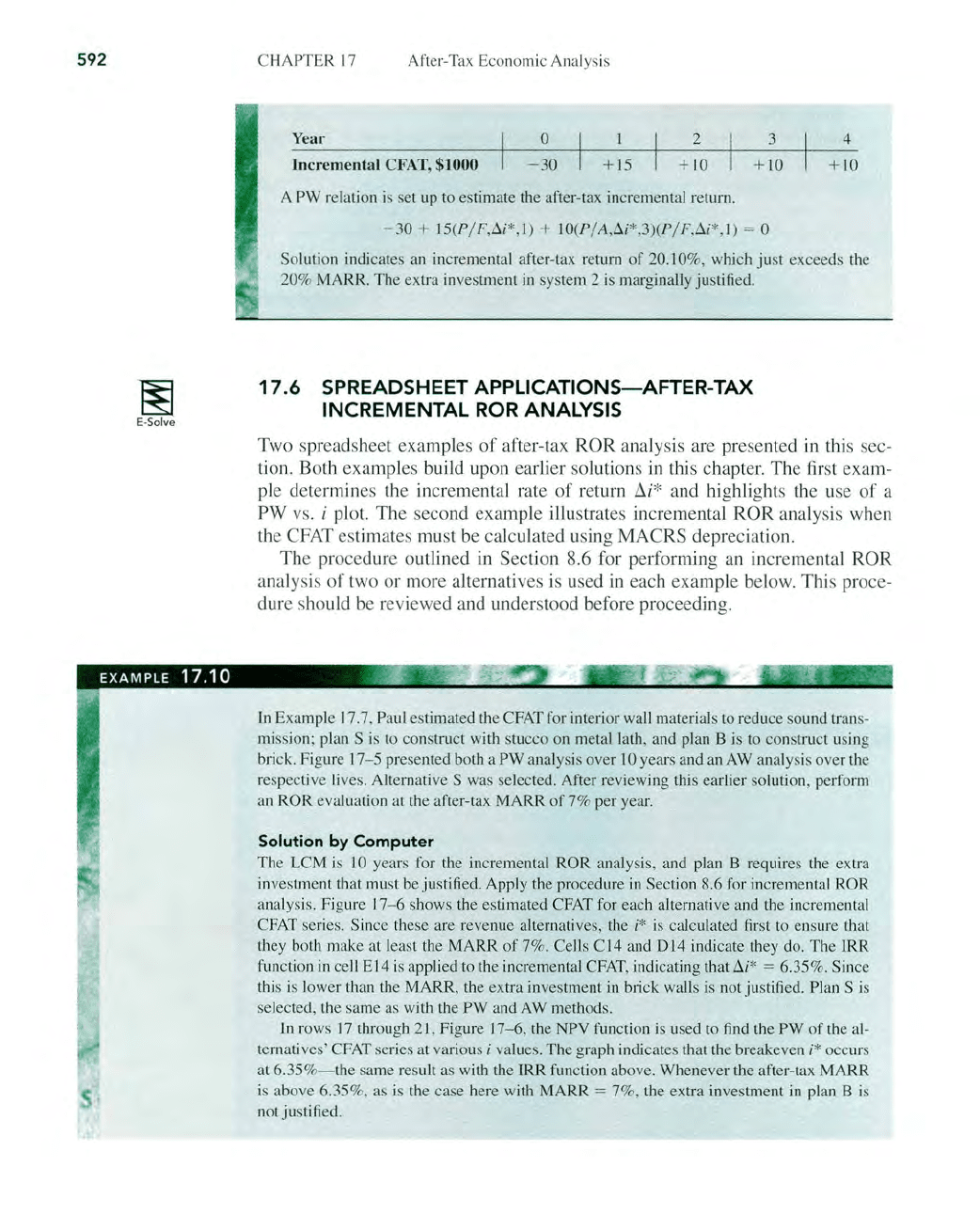
592
~
E-Solve
CHAPTER 17 After-Tax Economic Analysis
Year
o 2
3
4
Incremental
CFAT, $1000
-3
0
+15
+ 10
+
10
+
10
A
PW
relation is s
et
up
to estimate the after-tax incremental return.
-
30
+
15(P
/ F,tli*,I) +
10(P
/A,
t1i
*,3)(P/ F,t1i*,
J)
= 0
Solution indicates an incremental after-tax return
of
20.10%, which
just
exceeds
th
e
20% MARR.
The
extra investment in system 2 is marginally justified.
17
.6 SPREADSHEET APPLICATIONS-AFTER-TAX
INCREMENTAL
ROR
ANALYSIS
Two spreadsheet examples
of
after-tax
ROR
analysis are presented
in
this sec-
tion. Both examples build upon earlier solutions
in
this chapter. The first exam-
ple determines the incremental rate
of
return i1i':' and highlights the use
of
a
PW
vs
. i plot. The second example illustrates incremental ROR analysis when
the CFAT estimates must be calculated
Llsing
MACRS depreciation.
The
procedure outlined in Section 8.6 for performing an incremental
ROR
analysis
of
two
or
more alternatives
is
used in each example below. This proce-
dure should be reviewed and understood before proceeding.
In
Example 17.7, Paul estimated the CFAT for interior
wa
ll
materials to reduce sound tran -
mission; plan S is
to
construct with stucco on metal lath, and plan B is to const
ru
ct
us
in
g
brick. Figure
17- 5 presented both a
PW
analysis over 10 years and an
AW
analysis over the
respective
li
ves. Alternative S was selected. After reviewing this earlier solution, perform
an
ROR evaluation
at
the after-tax
MARR
of
7% per year.
So
lut
i
on
by
Computer
The
LCM
is
10
years for the incremental ROR analysis, and plan B requires the extra
investment that must be justified. Apply the procedure in Section 8.6 for incremental
ROR
anal
ys
is. Figure
17
-6
shows the estimated CFAT for each alternative a
nd
the incremental
CFAT series. Since these are revenue alternatives, the
i* is calculated first to en
su
re that
th
ey both make at least the
MARR
of
7%. Cells C14 and D14 indicate they do. The
lRR
fl.lllction in ce
ll
E14
is
applied to the incremental CFAT, indicating that tli* = 6.35
%.
Since
this
is
lower than the MARR, the extra investment in brick walls is not justified. Plan S
is
selected,
th
e same as with
th
e
PW
and A W methods.
In rows 17 through 21, Figure 17-6, the NPV function is used to find the PW
of
the al-
terna
ti
ves' CFAT series at various i values.
The
graph indicates that the breakeven i* occurs
at 6.35
%-
th
e same result as with the
IRR
function above. Whenever the after-tax MARR
is above 6.35
%,
as is the case here with MARR = 7%, the extra investment in plan B is
not justified.
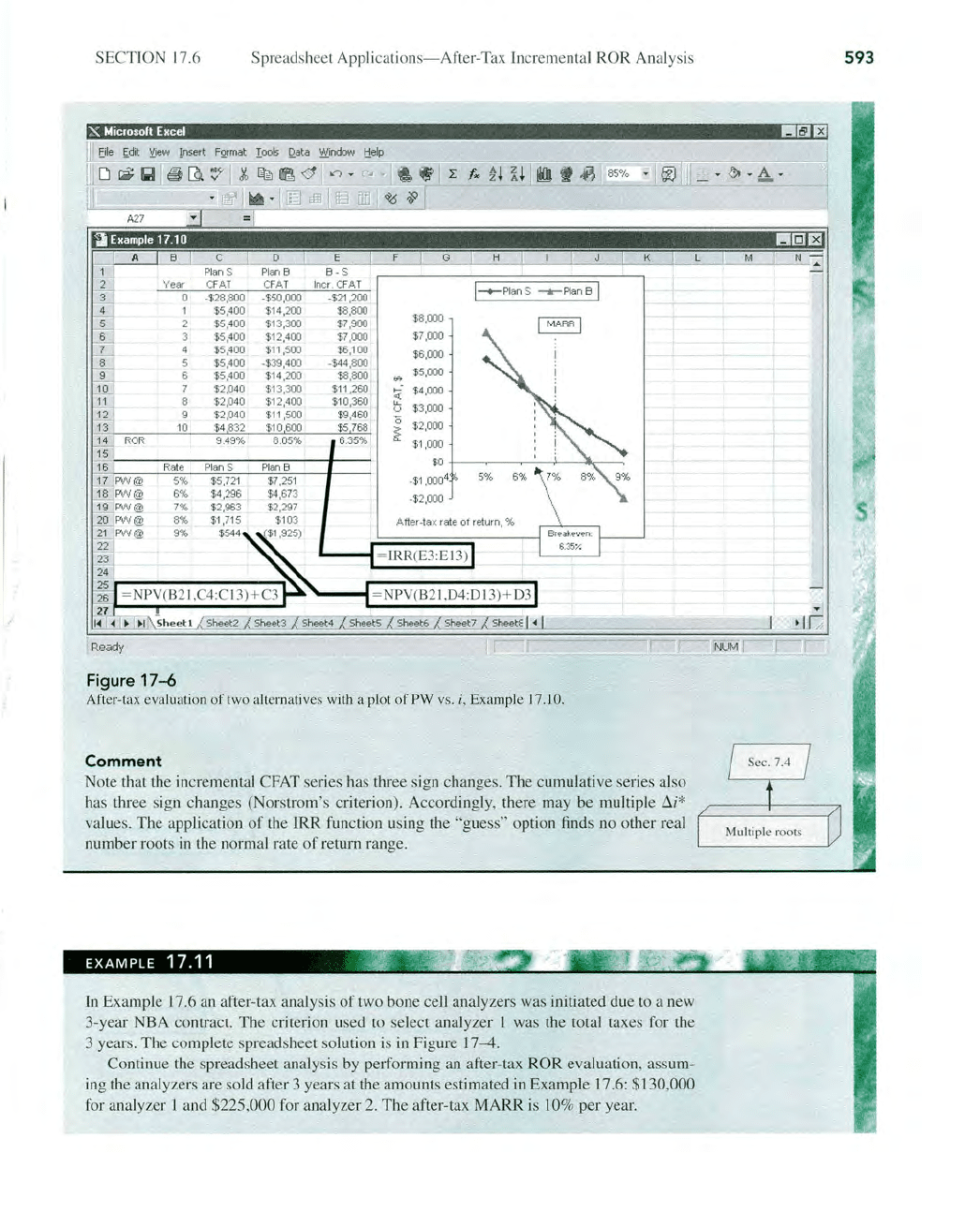
SECTION 17.6 Spreadsheet Application
s-A
Fter-Ta
x Incremental ROR Analysis
X Microsoll EKcel Br.Jf3
E.Ue
~dit
y'iew
Insert
FQ.rmat
Iools
!;lata
~i
ndow
A27
A
8 C 0 F
G H
K
L
Pl
anS
Plan 8
8-
S
Year CF
ln
CFAT Incr. CFAT
I--+-Plan S
-.-
Plan
8 I
0 -$28,800 ·$50,000 -$21,200
$5,400
$14,200
$8,800
$8,000
5
$5,400 $13,300 $7,900
$5,400
$12,400
$7,000
$7,000
$5,400 $11,500 $6,100
$6,000
$5,400 -$39,400
-$44,800
$5,400 $14,200 $8,800
$5,000
10
$2,040 $13,300 $11,260
.-
:
$4,000
«
'
11
$2,040 $12,400 $10,360
"-
$3,000
'12
$2,040 $11,500 $9,460
u
0
13
10
$48
32
$10600
$5768
~
$2,000
.1.1
ROR
9
.4
9%
8,05%
6
,3
5%
$1,000
15
j§.
Rate Pl
an
S
$0
17
FW@
5%
$5,721
·
$1
,000
4
'
~
18
FW@
6% $4,296
-$2
,0
00
19 F
W@
7% $2,963
~FW@
8% $1,715
21
FW@
9% $544
22
23
= lRR(E3
:EI
3)
24
= NPV(
B21
,
D4:DI
3)+ D3
Ready
--n~
INCJ
M
I
F
ig
ure
17-6
After-tax evaluation
of
two alte
rn
atives with a plot of PW
vs
. i, Example 17.10.
Comment
Note that
th
e
in
cremental CFAT se
ri
es has three sign changes.
The
cumulative se
ri
es also
has three sign changes (Norstrom's critelion). Accordingly, there may
be
multiple
t1i
*
va
lue
s.
The application
of
th
e lRR hlJ1ction us
in
g the
"g
uess" option finds no o
th
er
r
ea
l
number roots
in
the normal rate
of
retum range.
EXAMPLE 17,11 •
;:;:
.
IJ1
Example
17
.6 an after-tax analysis
of
two bone cell analyzers was initiated due to a new
3-year NBA contract. The criterion used
to select analyzer I was the total taxes for the
3 years. The complete spreadsheet solution is
in
Figure 17-4.
Continue the s
pr
eadsheet analysis by performing an after-tax ROR evaluation, assum-
in
g the analyzers
aJ'e
so
ld
after 3 years at
th
e
aJ110unts
estimated
in
Example 17.6: $1
30
,000
For
analyzer
land
$225,000 for analyzer 2. The after-tax MARR is 10%
per
year.
M
I~
>I
G
~r:-
593
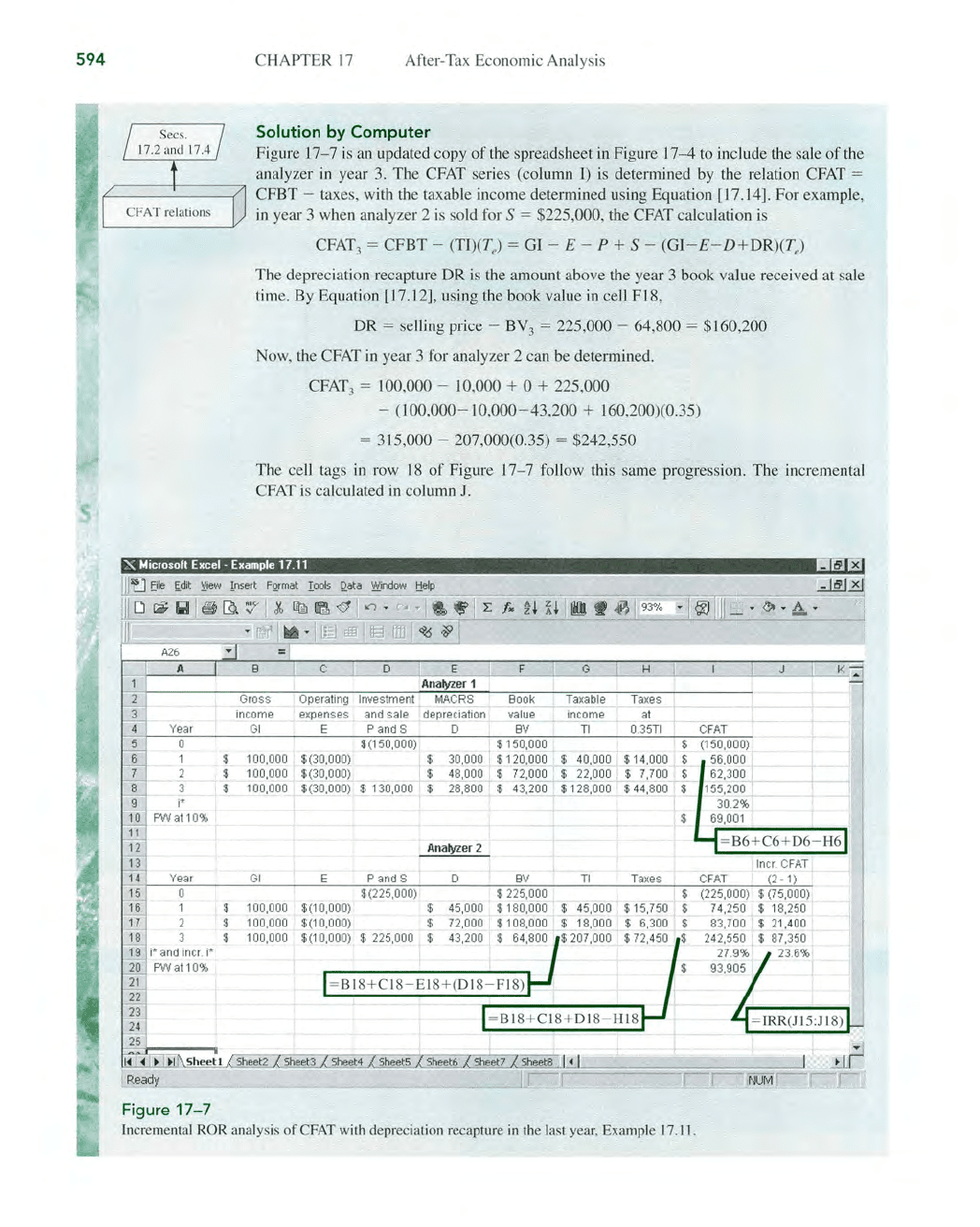
594
CHAPTER 17 After-T
ax
Econo
mi
c Analysis
Solution by Computer
Figure
17
-7
is
an updated copy
of
the spreadsheet in Figure
17
- 4 to include the sale
of
the
analyzer
in
year 3. The CFAT series (column I) is determined
by
th
e relation
CFAT
=
CFBT - taxes, with the taxable income determined using Equation [17.14]. For example,
in year 3
wh
en analyzer 2 is sold for S = $225,000, the
CFAT
calculation is
CFAT
3
= CFBT - (
TI
)(Te) = GI - E - P + S - (
Gl-E
- D +
DR
)(T
e
)
The depreciation recapture
DR
is the amount above the year 3 book value received at sale
time.
By
Equation [17.12], using the book value
in
cell F18,
DR
= selling price - BV
3
= 225,000 - 64,800 =
$J60
,200
Now, the
CFAT
in
year 3 for analyzer 2 can be determine
d.
CFAT
3
= 100,000 - 10,000 + 0 + 2
25
,000
- (100,
000-10
,000- 43,200 + 160,200)(0.35)
= 315,000 - 207,000(0.35) = $242,550
The ce
ll
tags
in
row 18
of
Figure
17
- 7 follow this same progression. The incremental
CFAT
is
calculated
in
column J.
X I.hcrosolt EHcel - EHample
1711
1!I~E3
3
5
6
7
8
9
10
11
12
13
14
15
16
17
18
19
20
21
22
23
24
25
Year
0
i'
PWat10%
Year
0
i*
and
in
cr. i*
PWat
10%
Gross
income
GI
1
00
,0
00
1
00
,000
100,000
GI
100,000
100,0
00
100,000
Operating Investment
expenses
and sale
E
P and S
$ (150,000)
$ (30,000)
$ (30,000)
$ (30,000)
$ 130,0
00
E P and S
$(225,000)
$(10,000)
$
(1
0,00
0)
$ (10,000)
$ 225,000
F
Analyzer 1
MACRS
Book
depreciation
va
lue
0
BV
$ 150,000
30,
0
00
$ 1
20
,0
00
4
8,
000
$
72,
000
28,800
$
43,200
Analyzer
2
0
BV
$ 225,000
45,000
$ 180,000
72
,000 $ 108,000
43,200
$
64,800-
fW-:l.JLJL,U
Sheet!
Sheet3 Shee
t4
SheetS
shee
t;;
Sh
eet7
Reagy
Figure
17-7
G H
Ta
xable
Ta
xes
i
ncome
at
TI 0.35TI
$
$ 40,000 $ 14,0
00
$
$
22
,000 $ 7
,7
00
$
$ 128,000 $
44
,8
00
$
TI
Taxes
$
45
.0
00
$
1
8,
00
0
$
$ 207,000
$
In
creme
nt
al ROR analysis
of
CFAT with deprecia
ti
on recapture
in
the last year, Example
17
.
11.
CFAT
(150,000)
56,000
62
,300
155,200
f
30.2%
69,001
=B6+
C6
+0 6- H6
Incr. C
FAT
CFAT
(2 - 1)
(225,000) $ (75,000)
74
,250 $ 18,250
83,700
$ 21,400 I
242,550 $ 87,350
27
.9% 23.6%
